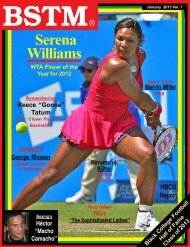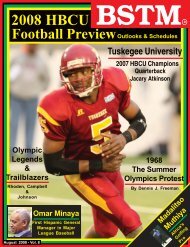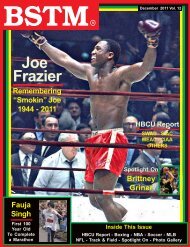June 2013 - Black Sports The Magazine
June 2013 - Black Sports The Magazine
June 2013 - Black Sports The Magazine
Create successful ePaper yourself
Turn your PDF publications into a flip-book with our unique Google optimized e-Paper software.
Association of <strong>Sports</strong> Editors (NNNAA) touted Robinson more<br />
than any other athlete. Members knew as well as Rickey that the<br />
first player to break the color line needed to be more than just a<br />
great athlete. In order to succeed, he also needed the social,<br />
emotional and intellectual skills to survive the scrutiny of a nation.<br />
Jack Roosevelt Robinson was born in Cairo, Georgia, in 1919 to<br />
a family of sharecroppers. His mother, Mallie, single-handedly<br />
raised Robinson and four other children. He was the youngest<br />
of the five children, after Edgar, Frank, Matthew and Willa Mae.<br />
Growing up in a large, single-parent family, Robinson excelled<br />
early at all sports, and learned to make his way in life. In high<br />
school, Robinson played several sports at the varsity level, and<br />
lettered in four of them: football, basketball, track and baseball.<br />
He played shortstop and catcher on the baseball team,<br />
quarterback on the football team Robinson and guard on the<br />
basketball team.<br />
After high school, Robinson attended Pasadena Junior College,<br />
where he played basketball, football, baseball and ran track. On<br />
the football team, he played quarterback and safety. He was<br />
shortstop and leadoff hitter for the baseball team, and he broke<br />
the school’s long jump record held by his brother Matthew “Mack”<br />
Robinson. In 1938, he was elected to the All-Southland Junior<br />
College Team for baseball, and was selected as the region’s<br />
Most Valuable Player.<br />
After graduating from junior college, Robinson transferred to the<br />
University of California at Los Angeles (UCLA), where he became<br />
the school’s first athlete to win varsity letters in four sports:<br />
baseball, basketball, football and track. In track and field, he<br />
won the 1940 NCAA Outdoor Track and Field Championship in<br />
the long jump. In 1941, he was named to the All-American football<br />
team. In the spring of 1941, he left college just shy of graduation,<br />
due to financial issues and the cost of college.<br />
In 1942, Robinson was drafted and assigned to a segregated<br />
Army cavalry unit in Fort Riley, Kansas. He had this can do spirit,<br />
the fight for justice, the ability to articulate a situation and find<br />
solutions. Having the requisite qualifications, he applied for Officer<br />
Candidate School (OCS), then located at Fort Riley. Although the<br />
Army’s initial July 1941 guidelines for OCS had been drafted as<br />
race-neutral, practically speaking, few <strong>Black</strong> applicants were<br />
admitted in OCS. After protests by heavyweight boxing champion<br />
Joe Louis, also stationed at Fort Riley, and civilian aides to the<br />
Secretary of War, he and other <strong>Black</strong>s were accepted to OCS.<br />
Robinson was commissioned as a second lieutenant in January<br />
1943.<br />
In July 1944, Robinson boarded an Army bus, and was asked to<br />
move to the back of the bus. He refused, and the bus driver had<br />
him arrested. When he confronted the investigating officer about<br />
racist questioning, the officer recommended he be courtmartialed.<br />
By the time of the court-martial in August 1944, the<br />
charges against Robinson had been reduced. He was acquitted<br />
by an all-White panel of nine officers.<br />
Robinson was honorably discharged from the Army. He returned<br />
to his football club, the Los Angeles Bulldogs. Later, he accepted<br />
an offer to be Athletic Director at Sam Huston College (renamed:<br />
Huston-Tillotson University) in Texas. In early 1945, while he<br />
was at Sam Huston, the Kansas City Monarchs sent him a written<br />
offer to play professional baseball in the Negro Leagues.<br />
Because of his great play with the Monarchs, he was chosen to<br />
play in the 1945 Negro League All-Star Game.<br />
After being signed to the Brooklyn’s International League farm<br />
club in October 1945, Robinson arrived in Florida in the spring of<br />
1946, and was met with bigoted acts and racist attitudes. But, he<br />
endured because he was on a mission to do well with the<br />
Montreal team and eventually play for the Brooklyn Dodgers. He<br />
led the International League in batting, and was named league<br />
Most Valuable Player. <strong>The</strong> Montreal (Canadian) fans treated him<br />
very well. He was their hero, and really helped the International<br />
League’s attendance.<br />
On April 15, 1947, Robinson became the first <strong>Black</strong> man to play<br />
in a modern Major League Baseball (MLB) game. He was derided<br />
by opposing teams. Some, notably the St. Louis Cardinals,<br />
threatened to strike if Robinson played. After the threat, National<br />
League President Ford Frick and baseball Commissioner Happy<br />
Chandler let it be known, that any striking players would be<br />
suspended. Robinson had to deal with threats to his life, rough<br />
physical play by opponents, name calling, serious injuries<br />
caused by other players trying to spike him, or pitchers sending<br />
pitches near his head.<br />
He was chosen the inaugural MLB Rookie of the Year in 1947.<br />
<strong>The</strong> Brooklyn Dodgers also won the 1947 National League<br />
Pennant. Robinson brought excitement to Major League<br />
Baseball. He brought new fans to the game, and a renewed<br />
interest. He became a hero, extremely popular and a legend.<br />
Branch Rickey, the innovator, had now helped to integrate<br />
baseball. While he was President and General Manager with<br />
Brooklyn, he opened a full-time spring training facility in Vero<br />
Beach, Florida. Rickey helped develop the batting cage, pitching<br />
machines, batting helmets and use of statistical analysis for<br />
baseball. He prepared the Dodgers to be competitive and to win<br />
the National League Pennants in 1947 and 1949. Rickey also<br />
developed the Dodgers into winners for the future. <strong>The</strong>y won<br />
National League Pennants in 1952, 1953, 1955, 1956 and 1959.<br />
<strong>The</strong> Dodgers won World Series Championships in 1955 and<br />
1959.<br />
Rickey sold his Brooklyn Dodgers interest in 1950, for more<br />
than a million dollars (a fortune in 1950). Later, he was offered<br />
the position of general manager for the Pittsburgh Pirates. He<br />
retired from baseball in 1955. <strong>The</strong> Pittsburgh Pirates won the<br />
World Series in 1960. This had a lot to do with Rickey preparing<br />
the team for success.<br />
Rickey must be credited with bringing so many innovations to<br />
the sport of baseball, techniques and ideas that also benefitted<br />
all sports. He discovered and helped to develop great players,<br />
like Baseball Hall of Famers Dizzy Dean, Joe Medwick, Enos<br />
Slaughter, Stan Musial, Roy Campanella, Pee Wee Reese, Jackie<br />
Robinson, Roberto Clemente, etc. It is Rickey’s signing of<br />
Robinson to the Brooklyn Dodgers that he will most be<br />
remembered.<br />
Robert E. Lewis is a management consultant, businessman,<br />
management/marketing professor and certified Educational<br />
Foundation Instructor. He can be contacted at:<br />
RShaft88@aol.com.<br />
Visit us at:<br />
www.bstmllc.com<br />
22 BSTM <strong>June</strong> <strong>2013</strong>












